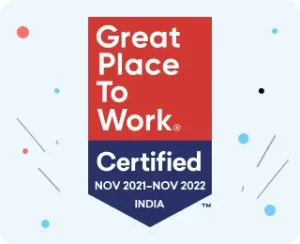Customer effort score (CES) has been gaining its share of popularity for over a decade now. It has clearly been accepted as a customer service metric along with net promoter score and customer satisfaction rate. Business leaders and customer experience managers have dived into the available information and practical implementation of customer effort scores so as to track and analyze customer experience.
Coined in 2008, the customer effort score was an innovation of the US Corporate Executive Board (CEB). It was recognized and commercialized in 2010 as Harvard Business Review had an article published with the title- “Stop trying to delight your customers.”
Clearly, the article covered the gap between customer loyalty and customer service. Delighting customers can only lead them to business for marginal loyalty, but by making the business processes and problem-solving easy, businesses can retain more loyal customers.
As per the Gartner survey, less than 10% of organizations have started using customer effort scores to analyze customer experience. This is because of the lack of clarity about the metric and its advantages. With different tools and metrics for measuring every business process, leaders and managers can be a little overwhelmed when it comes to measuring a new metric for customer experience.
In this article, we will be summarizing what customer effort score is, how it can affect your customer experience. We have also covered the basic differences between Net promoter score (NPS), Customer Effort Score (CES), and Customer Satisfaction (CSAT), in-depth. This article will cover everything that you need to know before you start measuring customer effort scores.
What is Customer Effort Score (CES)?
Customer effort score is a metric that measures the ease (or difficulty) with which customers are able to interact with your business. It simply gives an insight into the efforts that are needed from the customers’ end to reach out to your business during any phase of the journey. It is measured on a scale of 1-7 to measure the ease to complete a purchase from your business, request customer support, or just interact with your business, online or in person.
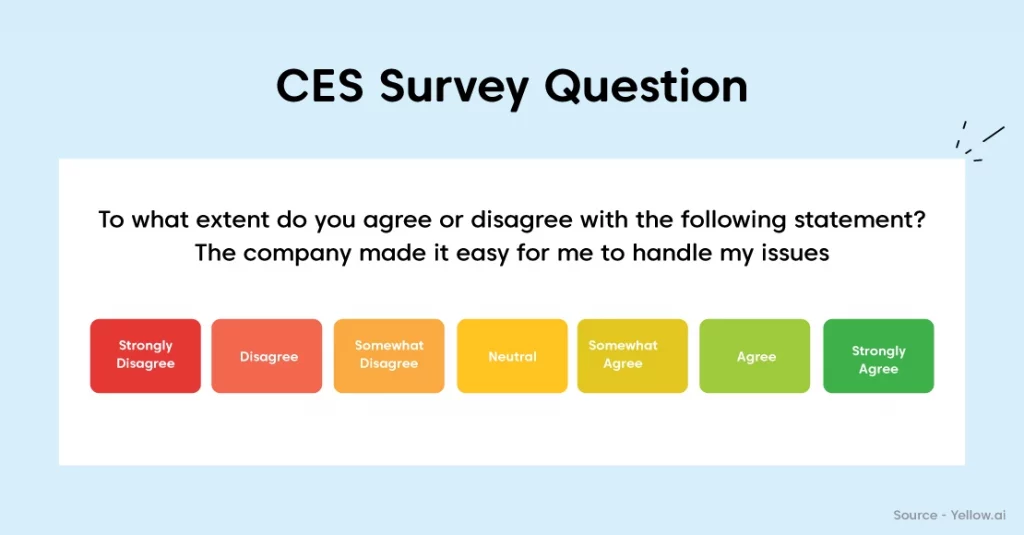
Let us take an example to get a better understanding. Suppose you as a customer visit an ice cream parlor. When you visit the place for the first time, you simply get your flavor and enjoy your ice cream.
Because of this simplicity, you decide to visit the store once again. This time, the picture is different. There is a long queue waiting for their ice creams.
What would you do? Personally, I would skip the plan and go home.
Analyzing the situation, a customer won’t care about the product and its value if you have a poor overall experience. The loyalty of a customer lies between the quality of the product and the customer experience. With a deep analysis of the customer effort score (CES), businesses can rectify their shortcomings in the CX and boost up their revenues and customer retention. By tracking this metric and working on the derived insights, businesses can clear all the blockers that a customer may face before reaching out to you.
Why choose Customer Effort Score (CES) over other metrics?
Organizations have been using Net Promoter Score (NPS) and Customer SATisfaction rate (CSAT) as customer experience metrics. Shifting to a new metric, creating a survey form, and getting feedback from customers can be a task. Businesses might face friction in bringing this shift and some might even prefer staying where they currently belong.
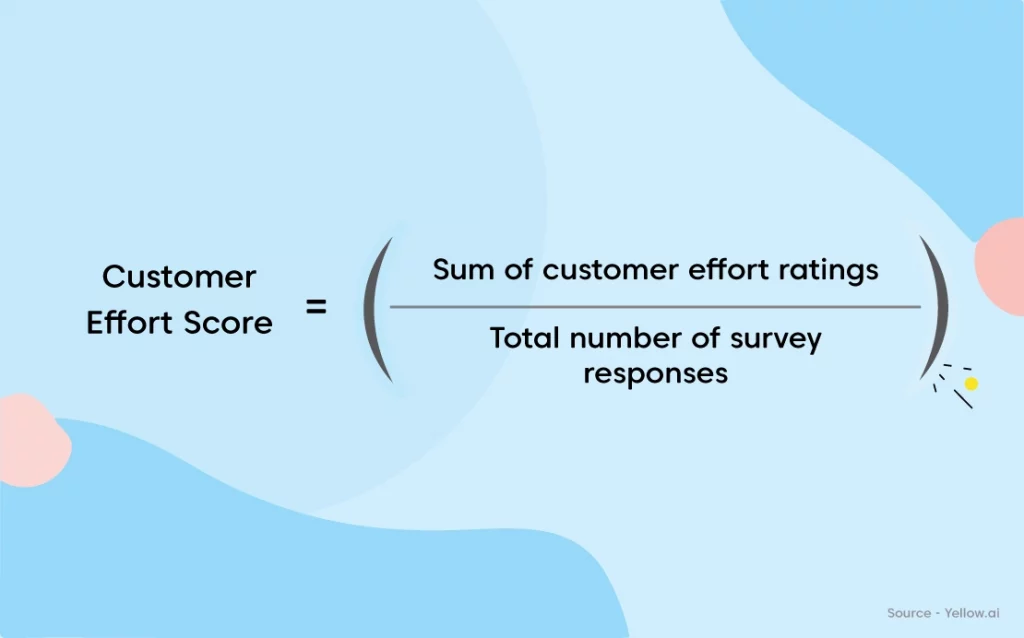
Here is the broader picture where you can compare different metrics and select the best one. This should be done by putting yourself in the customers’ shoes and visualizing benefits for both customers and business.
Comparison: Customer Effort Score (CES) vs Net Promoter Score (NPS) vs Customer SATisfaction (CSAT)
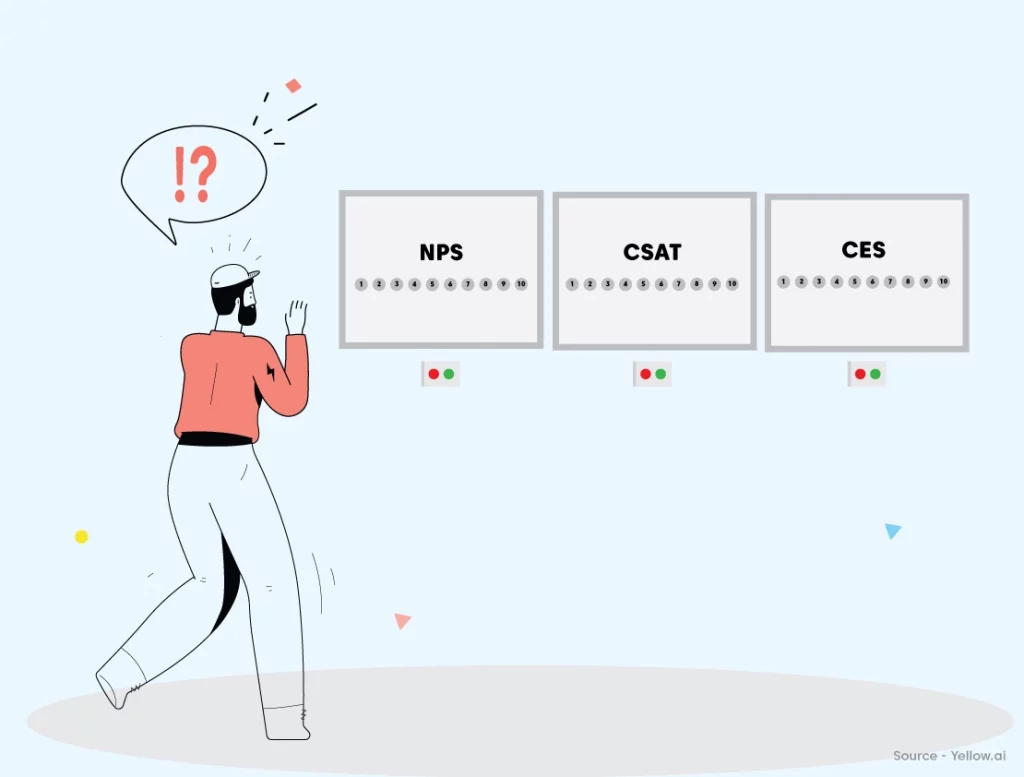
| Topic | Customer Effort Score | Net Promoter Score | Customer Satisfaction |
| Definition | A single-item metric to measure how much effort did a customer put in order to interact or purchase with your company. | A metric bifurcated as promoters, passives, and detractors, used to measure customer experience and tentative business growth. | Multiple questions to understand the overall happiness or disappointment of customers. |
| Motive | Best for measuring customer loyalty and analyzing the product or service. | Best for understanding if a customer is in for the long term and is ready to become a brand ambassador. | Best for analyzing short-term instant feelings of the customer. |
| Measurement scale | Measured on a scale of 1-7 | Measured on a scale of 1-10 | No universal scale. Can be measured between 1-3, 1-5, 1-7, or 1-10. |
| Sample questions | Overall, how easy was it to solve your queries with Yellow.ai? | How likely are you to recommend our product or services? | How long have you been using our services?How do our services help you in achieving your target? |
| Industry benchmark | In the past 12 months, an average customer effort score is 5.4. | Median NPS is +44. 25% of the companies using NPS even have a score of +72 or higher. | Anything between 25%-50% is considered a good CSAT. |
The basic outreach is about the complete customer experience survey. All of these metrics are used to understand customers’ perspectives better and improve the experience with every survey. Using any of these metrics as per your business’s priorities can help you obtain essential insights about how customers feel once they interact with your business.
Organizations also use a combination of these metrics for a better understanding of customers’ mindsets and expectations. However, just gathering this information is not enough. Companies that actually implement the required amendments win the CX game.
Let’s take a deeper look at how measuring customer effort scores can help your organization.
Benefits of tracking Customer Effort Score (CES)
The Corporate Executive Board (CEB) discovered that CES is 1.8x more predictive than the CSAT score and 2x more predictive than NPS in regards to customer loyalty.
Businesses want better and more effective customer experience metrics in order to improve their brand performance and customer loyalty. They need a deeper understanding before making any generous changes to any of the business processes. That is where the customer effort score comes into play. There are a number of benefits that come with measuring the customer effort score.
1. Better predictions about customer loyalty
Broadly classifying, there are 3 major metrics for measuring customer experience, CSAT score, NPS, and CES. CSAT and NPS majorly contribute to analyzing customer satisfaction and anticipating the likelihood of future purchases or customer referrals.
CES is the only metric that focuses on customer experience. It measures the ease with which customers can glide through their buyers’ journey and beyond.
Research by CEB depicts that today, customer loyalty is not dependent only on the fact of satisfaction. Customers tend to be more loyal to the brands with a smoother customer experience and less customer churn.
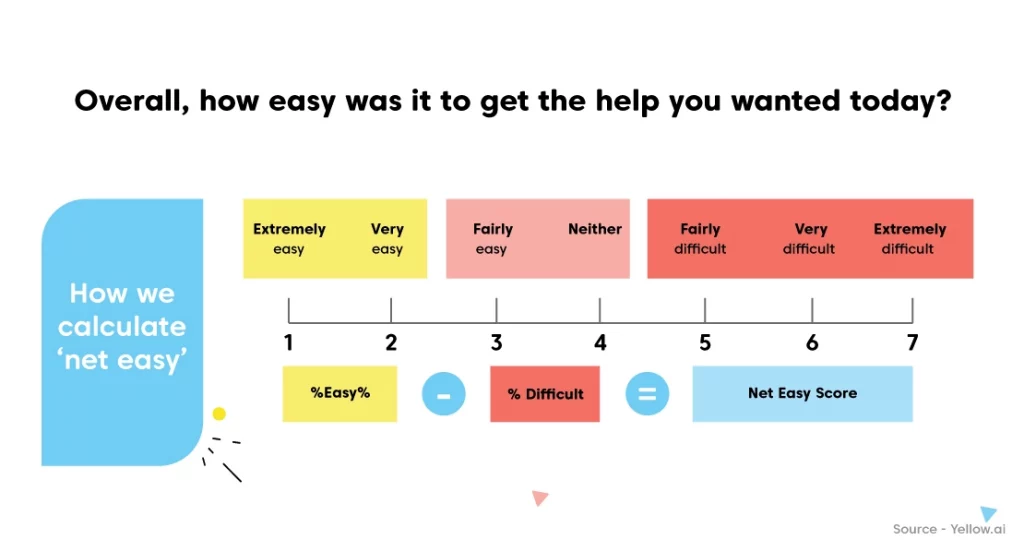
Customer effort score is directly proportional to customer loyalty. As easy as it is for a customer to interact with your business, better is customer loyalty. Your brand needs to shift to the customer effort score to clearly understand what your customers like or dislike about your brand and where is the customer experience lagging.
2. Business process specified metrics
Customer Effort Score (CES) is surveyed and calculated during different stages of the customer journey. That is why it gives highly effective and focused results regarding each and every business process.
Suppose, your organization wants to understand how efficient is your customer experience during the pre-purchase stage. You can survey CES with the question “How easy was it to find and understand services?”
The CES survey for the above example can give you an understanding of how efficient are your marketing strategies and content pieces in educating your target audience.
If a business process has a poor rating, the company can pay more attention to solving the problems for that particular process. Customers can be contacted by the particular domain responsible for poor customer experience.
With CES, companies can effectively keep a check on metrics for different business processes and target improving them based on the metrics.
3. Predictions about user purchase behavior
CES can help companies know exactly what customers are expecting. The complete flow of the business processes can be understood as per customers’ mindsets. With customer effort scores, companies can know how likely are the customers to come back to purchase with them.
As per the HBR article, 94% of the customers with a good customer experience and high CES tend to come back to the product or service. This fact gives an indication of the importance of calculating customer effort scores.
Customer behavior is highly dependent on each and every customer experience. Therefore, it is very important to keep on updating business processes according to customer expectations and customer behavior. This will give your business a competitive edge in the longer run.
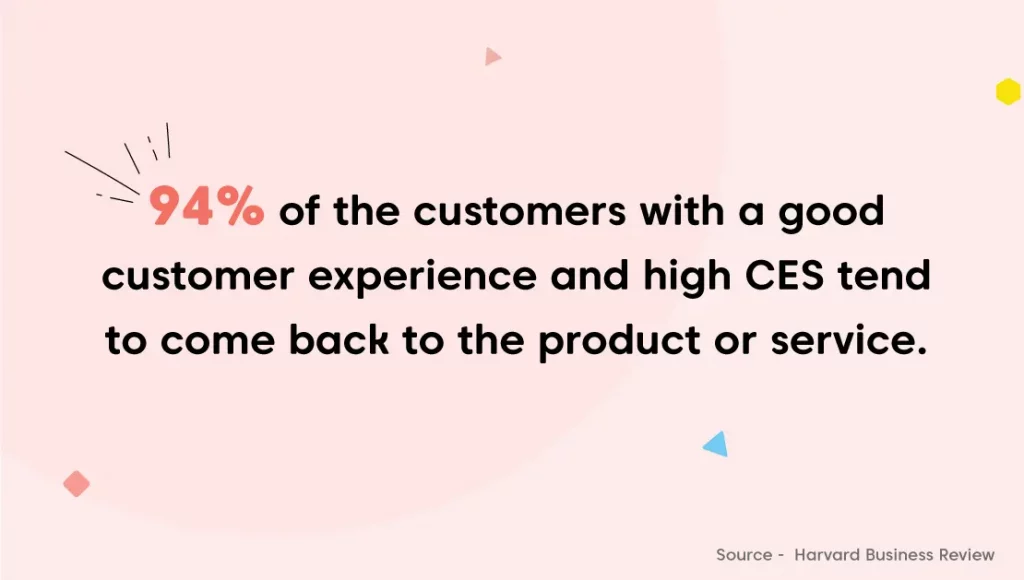
4. Anticipates customer referrals
Customers, when satisfied, tend to refer businesses to their colleagues, friends, and family. The customer effort score provides accurate anticipation of the likelihood of customer referrals.
As per the Harvard business review article, 81% of customers who had a bad customer experience and had to put the effort in engaging with a business said they would speak negatively about the business. This will clearly impact their referrals in a negative way.
However, NPS can be used along with CES, but it is not needed. Customer effort score in itself is a complete measure of customer experience and does not need another metric in combination.
By anticipating customer referrals, businesses can see their growth and upscale. If not, they can work on their shortcomings by deeply analyzing their CES. Keeping a regular check on this metric is essential as it changes with every amendment you make in the business process.
5. Reduces customer churn
With a continuous poor customer experience, customers will definitely churn out. If your website or application has many hindrances for customers, they will simply shift to your competitors.
Customer effort scores, once measured, can help businesses with a number of insights that are not easily visible.
Suppose you are running a business for the rural Indian audience. You need to make sure that your business communication happens in their native language or else your business model will not be a success.
Business must always think from the customer’s point of view and for that customer effort score is an essential measure.
How to improve Customer Effort Scores (CES)?
If you are a business already measuring customer effort scores and are looking for some solutions on improving it, we have a list of things that you can take care of.
1. Improve accessibility
Customers should not be trying to find you to contact you. Brands must be accessible from all platforms, in all languages, for all demographics, for every geography, and every time. This will not only make it easier for customers but also improve the brand recall value and brand image.
2. Improve self-serving processes
With self-serving business processes, customers don’t need to wait for any dependencies. A business process without any blockers is an ideal business strategy. There are a number of tools and software available to automate business processes and improve self-serving capabilities.
3. Improve average response time
Businesses must aim for a minimum average response time for the platforms that they use for communication. Keeping customers waiting for a response is not a good practice, no matter you run a small business or an enterprise.

A less average response time also builds trust in customers’ mindset for the business as they feel valued and heard.
4. Improve mobile friendliness
Most of the business is happening through mobile phones. All your communication strategies and transaction platforms must be mobile-friendly.
It is a must in today’s marketplace because each and every person wants the comfort of meeting all their needs from their fingertips. Mobile-friendliness is no more a competitive edge, it is a necessity.
5. Automate triggers
To avoid delays and customer churn, automating communication is the best solution. Specifying triggers to send out specific emails or messages can help ease the customer journey.
Also, automation can help in fewer abandoned carts and more satisfied customers. Designing a thoughtful flow of messages and automating them can depict great results for businesses.
6. Innovate new ways to reduce efforts from customers
Businesses must keep on innovating new business processes to simplify their customer journey. For example, Amazon’s one-click order gave customers a brilliant shopping experience and improved the brand value for amazon. Such innovations must be well-thought and must be easy for customers to shift to, or else they may even face backlash.
Providing customers with a good experience is the need of the hour.
Yellow.ai is a leading provider of world-class customer experience for all businesses on all channels. Schedule a demo with us to transform your CX and take your Customer Effort Score (CES) to the next level. We are here to help you with all your CX automation needs.









